The Dropmore Scarlet honeysuckle is a variety of Brown's honeysuckle. This plant stands out with its striking bright orange or scarlet flowers. After blooming, the decorative appeal of the bushes is enhanced by clusters of red-orange berries. The plant captivates with its lush green foliage, uniquely shaped leaves, and elegant vines that densely cover supports. Read on to learn about planting and caring for Brown's Dropmore Scarlet honeysuckle.
Table of contents
Description of Brown's Dropmore Scarlet Honeysuckle
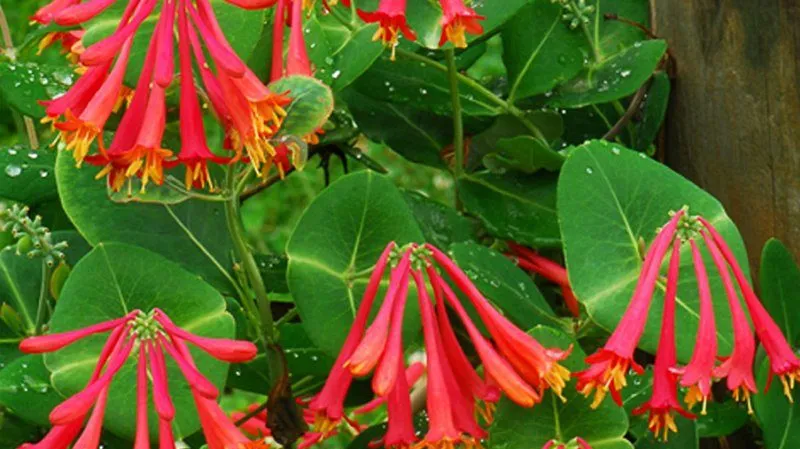
In the mid-19th century, breeders conducted an experiment by crossing rough and evergreen honeysuckle. The result was unforgettable. The plant bloomed long and profusely, stunning with its beauty—its flowers resembled fuchsia. Gardeners took an interest and began actively using it for landscaping. The honeysuckle earned the nickname "fuchsia-flowered."
Brown's Dropmore Scarlet honeysuckle belongs to the Brown hybrid group. It is a hybrid of rough honeysuckle (Lonicera hirsuta) and evergreen honeysuckle (Lonicera sempervirens). It was developed in 1950 in Manitoba, Canada, by breeder Frank Skinner.
The scientific name of Brown's honeysuckle is Lonicera brownii. It is a semi-deciduous shrub reaching about 2.5 meters in height. Young shoots have a purple hue.
The leaves are oval, leathery, and dark green with a bluish underside. The leaves fuse in pairs at the shoot tips, forming an elliptical disc. Foliage emerges in mid-May.
The flowers are arranged in whorled clusters of 6–35, with a tubular-bell shape. Each flower is about 6 cm long. The outer petals are orange, scarlet-red, or purple-pink, while the inner ones are yellow or scarlet. Blooming is abundant, starting in early June–July and lasting until September–October.
The berries are inedible, spherical, red-orange, and grow in clusters on stems. These bright fruits extend the plant’s decorative appeal for 2–4 weeks after flowering ends. They contain small seeds, up to 3 mm in size.
Note. Abundant fruiting occurs in regions with long summers.
Growing Conditions
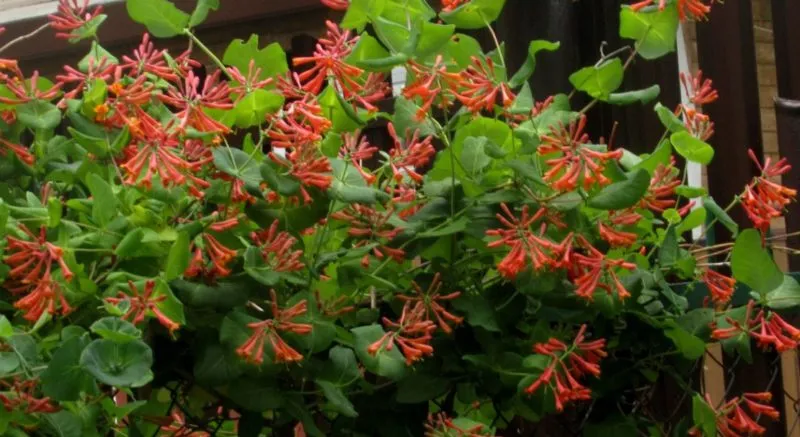
Brown's honeysuckle is hardy, frost-resistant, and easy to care for. It tolerates short droughts, spring frosts, and diseases well. Thanks to dense branching and a compact crown, it takes up little space, making it ideal for European gardeners to use on trellises.
Choosing a Location and Preparing the Soil
The plant prefers sunny spots with shade at the base. Mulch—such as bark, straw, or sawdust—helps achieve this. A low fence or dense planting of meter-tall flowers on the south side provides additional shade.
Honeysuckle loves moisture, so it can be planted in low-lying areas where rainwater collects. The only soil requirement is that it should not be waterlogged. The ideal pH range is 5.5–6.5, though it tolerates 3.9–7.7. Neutral or slightly acidic soil is best.
A soil mix can be prepared from garden soil, peat, compost, and sand in equal parts (1:1:1:1), though Dropmore Scarlet grows in almost any soil type. In poor soils, water 1–2 times depending on weather, and fertilize 3–4 times a year.
The plant dislikes drafts, so shelter from strong northern winds is essential. It withstands temperatures down to -27°C if shielded from wind.
Planting Guide
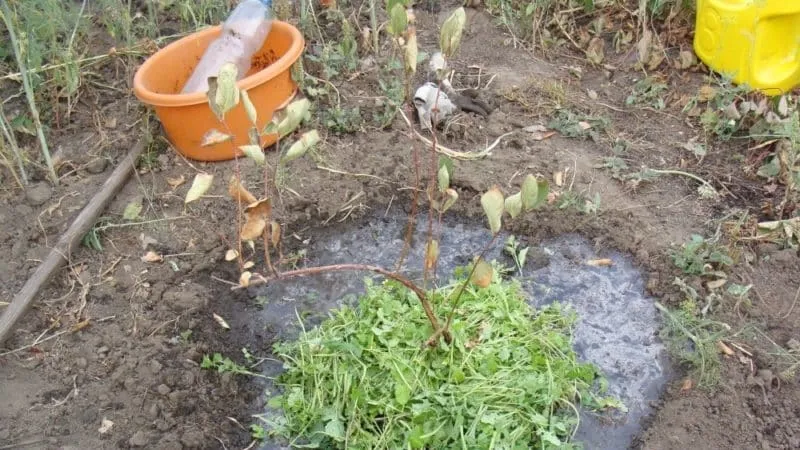
Plant on the southeast or southwest side of a house. Seed propagation is rare due to slow results—flowering begins only after 3–4 years. Instead, cuttings or layering are preferred, often yielding blooms in the first or second year.
Hardwood cuttings are taken in early spring during pruning. Cut 20 cm sections, leaving three buds per cutting. In mid-March, plant them halfway into moist soil, keeping humidity consistent.
For green cuttings, wait until after flowering. Select thick shoots (3–5 mm), cut 20 cm sections with 3–4 leaf pairs, and remove lower leaves. Plant at an angle and cover with plastic bottles (bottom or neck removed). Rooting takes 1–2 months.
Plant saplings in autumn at the end of the growing season. Container-grown plants can be planted anytime except winter.
Planting steps:
- Dig holes 25×25 cm for two-year-old saplings or 50×50 cm for 5–6-year-olds.
- Add 5 cm of gravel for drainage.
- Mix turf, sand, and compost (3:1:1) and partially fill the hole.
- Place the sapling and cover with soil, keeping the root collar exposed.
- Space plants 1.5 meters apart.
Care Instructions
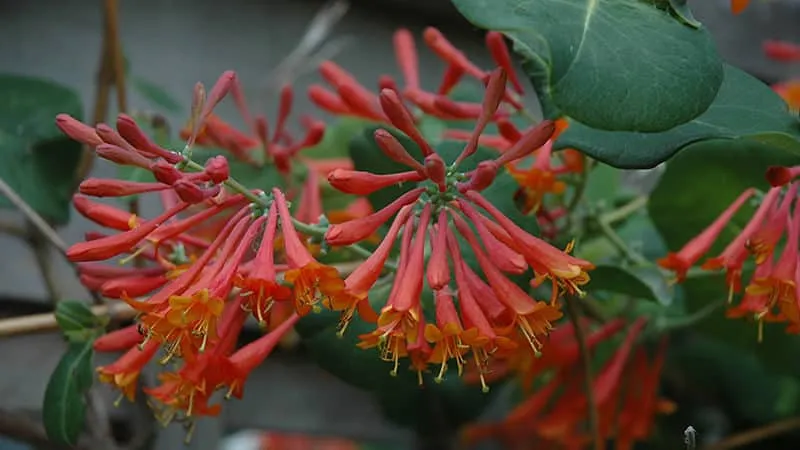
Young plants should be covered in winter with 2–4 layers of horticultural fleece. Remove cover when snow melts to prevent condensation. Mature shrubs in colder regions may also need protection.
Care rules:
- Water when the soil dries out. In hot weather, mist the foliage. Use 10 liters per plant, watering in the evening to minimize evaporation.
- Fertilize after three years. From spring until mid-June, apply nitrogen every two weeks. Dissolve 30 g of urea in 10 liters of water. Avoid excess nitrogen—it promotes excessive foliage. For poor soils, add 200 g of wood ash or 30 g of superphosphate.
Dropmore Scarlet is resistant to diseases and pests. Basic care is enough to keep it healthy.
Pruning
In the first year, provide support for shaping. Train vines along trellises or fences. Once the desired height is reached, trim the tops to encourage side growth.
Prune in early spring or late autumn. For the first five years, perform sanitary pruning—remove dead or damaged branches. Later, trim old stems back to 30–50 cm from dense growth points.
Landscaping Uses
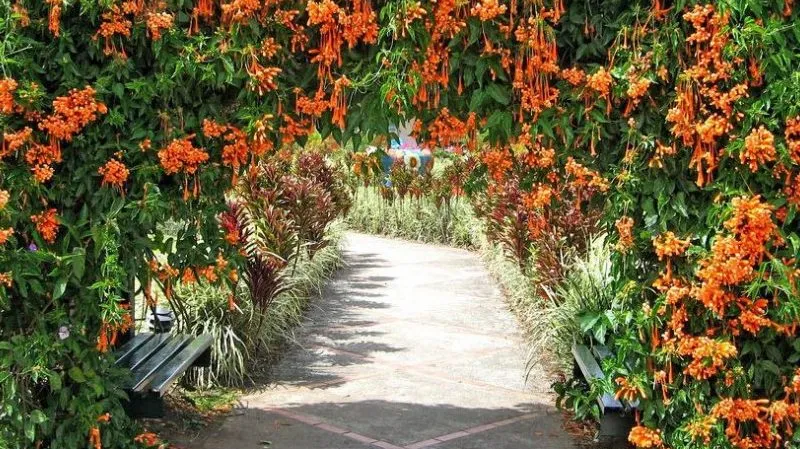
Brown's honeysuckle is perfect for hedges, fences, and wall covers. In the first year, growth is modest, but later, vines quickly climb 2–5 meters.
Pair it with poppies, roses, peonies, cypress spurge, or conifers. Use it to cover fences, create flowering carpets on netting, or enhance garden structures.
Testimonials
Gardeners love Dropmore Scarlet for its beauty and ease of care.
Sophie, France: "Three years ago, my husband and I planted Brown's honeysuckle at our countryside home. We spend summers there and wanted to beautify the space. I dabble in landscaping and decided to try a 'green carpet' effect. We used saplings for faster results—it bloomed the next year and grew quickly. The orange-red flowers are stunning!"
Lukas, Germany: "Our Dropmore Scarlet is over six years old. It’s so easy to care for, even for beginners like me. I planted saplings in autumn, and they bloomed by spring. Now, it covers an unsightly wire fence beautifully. I prune yearly and fertilize with wood ash."
Elena, Italy: "Brown's honeysuckle is ideal for garden charm. It survives harsh winters if covered. I use burlap and remove it in spring. Some branch tips freeze, but they recover after pruning. Water weekly, feed with nitrogen, and prune—simple!"
Conclusion
Brown's Dropmore Scarlet honeysuckle is a decorative hybrid prized for winter hardiness and low maintenance. It’s perfect for landscaping, creating vibrant hedges with its lush vines. The bright orange or scarlet flowers make a striking impression. Even novice gardeners can succeed with basic care—watering, feeding, and occasional pruning.







